Check out our range of stock.
Didn't find what you like?
Send us a message
Found something out of stock?
Send us a message

Hikari Micro Pellet is a semi-floating granule with an optimal blend of carefully selected proteins in a new QIK-COLOR formulation. The unique Micro Coating prevents nutrient loss and water clouding. Premium marine and vegetable proteins ensure an ideal diet for small fish requiring larger energy reserves. Krill and Spirulina offer vivid coloration. The red granule improves underwater visibility for the fish, resulting in better acceptance and less wasted food. Suitable for: Tetras, Barbs, and other small-mouthed fish. Feed 2-3 times a day but only an amount the fish will consume within a few minutes (18 – 30 Celsius). It is always best to underfeed rather than overfeed. Remove all uneaten food after feeding to help maintain water quality. Crude Protein: min 43%; Crude Fat: min 7%; Crude Fibre: max 7%; Moisture: max 10%; Crude Ash: max 17%; Phosphorus: min. 1.1% Made in Japan
$28.95

Hikari Micro Wafers are the smallest wafers for all types of tropical fish for superior color enhancement. Rich is Spirulina and Astaxanthin.Contains high-grade marine and vegetable proteins efficient digestion, ready acceptance, and superior nutrient utilization.Suitable for: All small and medium fish especially Tetras, Livebearers, Cichlids, and Catfish.Feed 2-3 times a day but only an amount the fish will consume within a few minutes (18 – 30 Celsius).It is always best to underfeed rather than overfeed. Remove all uneaten food after feeding to help maintain water quality.Crude Protein: min 44%; Crude Fat: min 8%; Crude Fibre: max 2%; Moisture: max 10%; Crude Ash: max 13%;Made in Japan
$10.95

Hikari Micro Wafers are the smallest wafers for all types of tropical fish for superior color enhancement. Rich is Spirulina and Astaxanthin.Contains high-grade marine and vegetable proteins efficient digestion, ready acceptance, and superior nutrient utilization.Suitable for: All small and medium fish especially Tetras, Livebearers, Cichlids, and Catfish.Feed 2-3 times a day but only an amount the fish will consume within a few minutes (18 – 30 Celsius).It is always best to underfeed rather than overfeed. Remove all uneaten food after feeding to help maintain water quality.Crude Protein: min 44%; Crude Fat: min 8%; Crude Fibre: max 2%; Moisture: max 10%; Crude Ash: max 13%;Made in Japan
$14.95
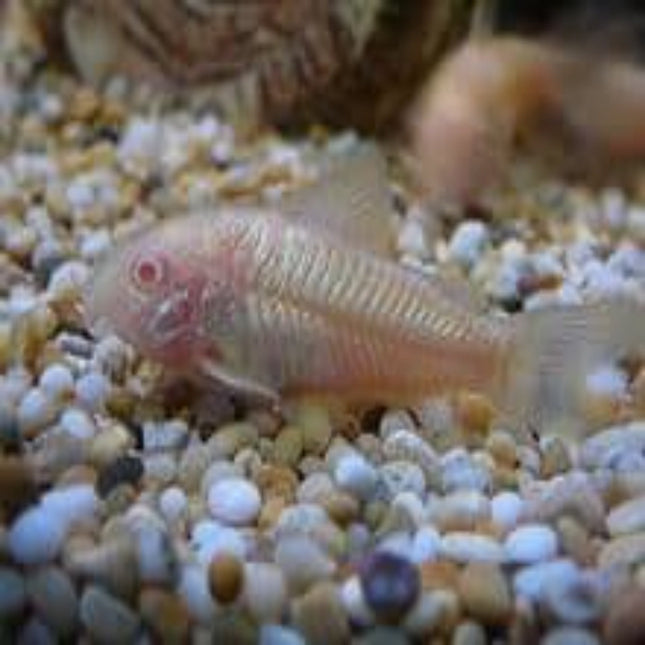
Albino Bronze Corydoras are a popular and colorful species of freshwater fish that are often kept in home aquariums. These fish are a member of the catfish family, and are known for their peaceful temperament and social nature, making them a great choice for community tanks. Albino Bronze Corydoras are a relatively small fish, typically growing to be around 2.5 inches in length. They have a distinctive bronze coloration with a white underbelly and red eyes, which is why they are called "albino." The bronze coloration can vary in intensity from fish to fish, with some appearing more metallic than others. In addition to their striking appearance, Albino Bronze Corydoras are also known for their hardiness and adaptability. They are able to tolerate a wide range of water conditions, making them a great choice for beginner aquarists. They prefer soft, acidic water with a pH between 6.0 and 7.0, and a temperature between 72 and 78 degrees Fahrenheit. Albino Bronze Corydoras are also bottom-dwellers, meaning they spend most of their time foraging on the substrate for food. They are omnivores, and will eat a variety of foods including sinking pellets, flakes, and live or frozen foods such as bloodworms and brine shrimp. These fish are social creatures and prefer to be kept in groups of at least six or more. They are known for their playful behavior, often seen darting around the tank and exploring their surroundings. Providing plenty of hiding places and plants in the aquarium will allow them to feel secure and comfortable. Albino Bronze Corydoras are easy to breed in captivity, and can often be induced to spawn with a water temperature increase and frequent water changes. They are egg-layers, and will lay their eggs on plants or other surfaces in the aquarium. The eggs will hatch in 2-3 days, and the fry will be free-swimming within a few days after that. In conclusion, Albino Bronze Corydoras are a beautiful, hardy, and social species of freshwater fish that make a great addition to any home aquarium. Their playful behavior, adaptability, and ease of care make them a great choice for beginner and experienced aquarists alike. Whether you are looking to start a new community tank or add to an existing one, Albino Bronze Corydoras are definitely worth considering.
$10.00
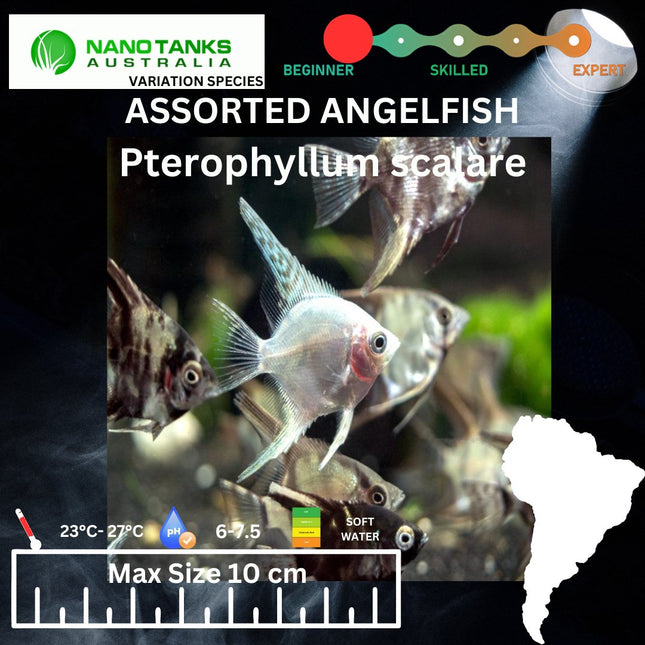
These Asssorted Angelfish are a variety of Pterophyllum scalare, which originated from the Amazon Basin, Orinoco Basin and various rivers in the Guiana Shield in tropical South America and are thus freshwater fish. Angelfish distinguish themselves from other cichlids in that they are strong laterally compressed, yet have a round body and elongated triangular dorsal and anal fins. These elegant yet strikingly shaped fish are popular with both beginner and experienced aquarists alike, and are a joy to observe. When buying Angels for breeding purposes, it is recommended to buy a group of 6 and let them pair off naturally. Once a pair is formed you want to move them to a breeding tank. Temperature: 24 – 28°C pH: 6.5 – 7.8 Lifespan: 10+ years Size: 10cm + Diet: Omnivore
$10.00 - $20.00

Banana Lily Nymphoides Aquatica – An Atypical Aquarium Plant for Beginners Nymphoides Aquatica is a lovely aquatic plant that can be used in any pond or planted aquarium. It natively grows along the southeastern United States from Texas to Maryland and has been known various names such as Banana Lily due to its banana-shaped roots. Banana Lily Factsheet Scientific Name: Nymphoides Aquatica Native To South/Southeastern United States Skill Level: Easy Placement: Foreground - Midground CO2 Requirements: none Warning: Banana plants do best if rested on top of the substrate or buried to about 1/4 inch so the plant can send roots down into the substrate. If buried too deeply, the plant may rot and eventually die. Also Snails and plecos are known to eat banana plants! How To Plant Your Banana Plant Introducing a new banana lily to your aquarium is very easy. First, make sure that you have at least two inches of substrate in the tank, such as gravel or sand, and select an area with good lighting conditions and gentle water flow. To keep your plant in place, make sure to rest the plant's tubers on top of the substrate gently. You can also bury them a quarter-inch into the ground if you want it firmly rooted there immediately. Don't worry if none of these methods work for whatever reason, and they still refuse to stay put! They will eventually send down long roots that attach themselves with help from gravity, so this is just something temporary until then - patience is critical when dealing with these plants! At up to 15cm tall, this species can be used for foreground plants, midground planting, or even as background plants for small tanks like 20 litre nano tanks. How To Care For a Banana Lily Banana lilies have a moderate growth rate, and they won't get out of control, making them perfect for beginners and those with limited space. They prefer temperatures between 20 to 28°C and can survive in low-light conditions. (The more light you give it, the faster it'll grow.) These easygoing fellows don't even require CO2. They are hardy little plants! If you want your banana lily to thrive over time, though, be sure to provide an all-in-one liquid fertiliser every three or four months. Not only will this keep their roots healthy but also stimulate cell division within shorter periods so new leaves form much quicker too. At first, the long shoots will grow toward the surface of your tank and start shooting up heart-shaped leaves, which look like lily pads in some cases with small white five petalled flowers. These plants are great for helping filter out excess nutrients from your water while adding an aesthetic beauty that most other aquatic plants can't offer. Just be careful not to let these floating leaves block all of the light from reaching other plants as well - make sure you prune them if needed. There are many ways that the banana lily may perish after planting. One of these possibilities is if its tubers melt away and disappear. There have been a few theories as to why this happens, but no solid explanation. Perhaps the plant doesn't need the lily anymore because it's getting enough nutrients from the roots. Even when plants start looking unhealthy, they can still grow strong with time. How To Grow More Banana Plants Have you ever wondered how to grow banana plants? It's easy! Cut off one of the leaves and let it float around in your tank. Eventually, new roots will appear with some small leaves, which can then be planted back into the substrate. Since banana is in the name, is the Banana Lily at all edible? Banana lily has no known direct food value to wildlife. However, even though it can't be consumed by animals directly, submerged portions of all aquatic plants provide habitats for many micro and macro invertebrates, which are used as food for the animal world. Inevitably when these plants die, their decomposition provides much-needed sustenance that feeds a variety of other underwater denizens. In the home aquarium, the Banana Lily is purely for aesthetics, water quality, and somewhere for smaller fish and shrimp to hide. Variations of Delivery Usually what you get on this picture is what you will receive. Sometimes however you will be getting a leaf. If you do the banana lily will sprout at the base of the leaf
$10.00
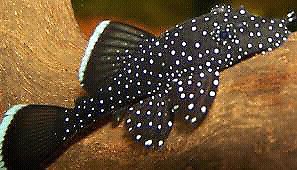
Introducing Peppermint Bristlenose! These stunning fish boast a festive, peppermint pattern and grow to approximately 3cm. Their unique appearance is a perfect addition to any aquarium, bringing a touch of color and interest. Add a splash of excitement to your tank with Peppermint Bristlenose! PLEASE NOTE THAT WE WILL NOT BE SHIPPING PEPPERMINTS UNTIL LATE AUGUST TO LATE MARCH DUE TO WEATHER. THANKS FOR UNDERSTANDING. IF YOU ARE LOCAL THEN PICKUP OR SAME DAY DELIVERY IS OK ALL SEASONS.
$40.00 - $100.00
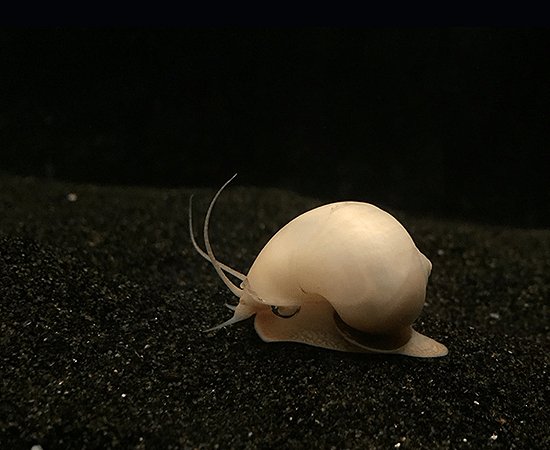
Unleash a beautiful addition to your aquarium with the Ivory Mystery Snail! Its stunning ivory color will bring a touch of elegance to any tank. Plus, this snail is known for its ability to clean and aerate your tank, promoting a healthy environment for your aquatic pets. Care Level: BeginnerTemperament: CalmColoUr Form: Brown, Black, Blue, Purple, Gold and WhiteLifespan: One YearSize: 2 InchesDiet: HerbivoreFamily: AmpullariidaeMinimum Tank Size: 5 GallonTank Set-Up: Moderate Vegetation, AdaptableCompatibility: Community Tanks
$15.00
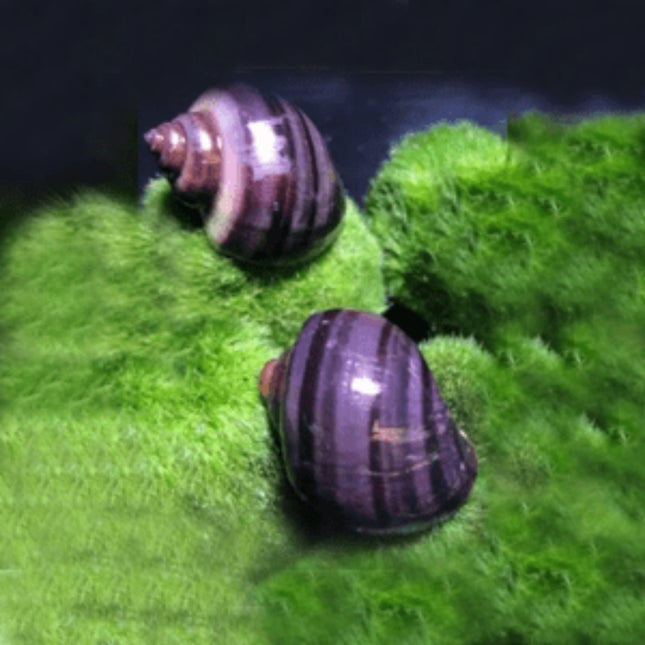
Purple Mystery Snails are a new variant of the Golden and the Brown/ Tortoise Mystery Snails. They are very new still in Australia and will be regarded as a very high demand species. If you are keen to have something new and rare in your tanks then consider this species. Nano Tanks Australia Aquarium Shop is proud to present this species to the Australian market. We are pleased that in 2020 we are able to bring this to our customers. Stocks are extremely limited so please hurry PLEASE NOTE THAT THE SNAILS ARE BEST KEPT IN pH 6.5 to 7.8 and temperatures between 22 to 26C. Shells conditions Sometimes you may get a snail that has pits on the shells. Purple mystery snails of all the mystery snail strains suffer extensively due to this and its usually a genetically induced affect. We recommend that you add a lot of calcium in your tanks like coral rubble to counteract this. No shipping to WA
$15.00

Unlock the full potential of your planted aquarium with Seachem Flourish Iron™. This highly bioavailable iron supplement is specifically formulated to prevent and correct iron deficiencies, which are a primary cause of poor growth and pale, chlorotic leaves. Give your plants the essential micronutrient they need to achieve deep, rich green coloration and thrive. Key Features & Benefits: Prevents Chlorosis: Directly targets iron deficiency, the main cause of yellowing leaves, especially in new growth. Highly Bioavailable: Features a ferrous iron gluconate compound that plants can absorb and utilize immediately and efficiently. Promotes Vibrant Coloration: Ensures your plants can produce lush, green chlorophyll for stunning visual health. Ideal for Fast-Growing & Demanding Plants: A must-have for keeping advanced species like red plants, carpeting plants, and stem plants healthy and vibrant. Safe for All Aquaria: Perfectly safe for fish, invertebrates, and beneficial bacteria when used as directed. Product Details: Product Name: Seachem Flourish Iron™ Size: 100 ml Type: Comprehensive, highly bioavailable iron supplement. Use: For all freshwater planted aquariums. How To Use: Dosage: Use 1 capful (5 mL) for every 200 L (50 US gallons) daily or as needed. Application: For precision dosing, use a syringe. Disperse evenly into the aquarium. For maximum benefit, add after a water change. Note: Dosage can be adjusted based on plant density and individual tank needs. Iron is typically consumed rapidly, so more frequent, smaller doses are more effective than one large weekly dose. Who is this product for? Seachem Flourish Iron™ is essential for: Aquarists battling yellowing or pale plant leaves. Keepers of high-light, CO2-injected planted tanks. Hobbyists growing demanding plant species. Anyone using a comprehensive fertilization regimen who needs to supplement a specific micronutrient. The Seachem Flourish® Range: Flourish Iron™ is part of the complete Seachem Flourish® nutrient system. For comprehensive care, combine with: Flourish®: A comprehensive baseline supplement for macro and micronutrients. Flourish Excel®: A source of bioavailable organic carbon. Flourish Potassium™ & Flourish Nitrogen™: To supplement specific macronutrients. Order with Confidence: This 100ml bottle is the perfect size for small to medium aquariums or for trying the product. For larger tanks, please see our larger size options. FAQ Section (Suggested for the product page): Q: How do I know if my plants need iron?A: The most common sign is chlorosis—yellowing or pale leaves, especially in the newest, youngest growth while the veins may remain green. Stunted growth is another key indicator. Q: Can I overdose with Flourish Iron?A: While safe when used as directed, extremely high doses of iron can be detrimental to some plants and shrimp. It is always best to start with the recommended dose and adjust gradually based on plant response. Q: Is this enough on its own, or do I need other fertilizers?A: Flourish Iron™ is a supplemental source of one specific micronutrient. Plants also require macronutrients (Nitrogen, Phosphorus, Potassium) and other micronutrients. For a full fertilizing regimen, you will need a comprehensive fertilizer like Flourish® or the full Flourish® range.
$18.00

Unlock the full potential of your planted aquarium with Seachem Flourish Iron™. This highly bioavailable iron supplement is specifically formulated to prevent and correct iron deficiencies, which are a primary cause of poor growth and pale, chlorotic leaves. Give your plants the essential micronutrient they need to achieve deep, rich green coloration and thrive. Key Features & Benefits: Prevents Chlorosis: Directly targets iron deficiency, the main cause of yellowing leaves, especially in new growth. Highly Bioavailable: Features a ferrous iron gluconate compound that plants can absorb and utilize immediately and efficiently. Promotes Vibrant Coloration: Ensures your plants can produce lush, green chlorophyll for stunning visual health. Ideal for Fast-Growing & Demanding Plants: A must-have for keeping advanced species like red plants, carpeting plants, and stem plants healthy and vibrant. Safe for All Aquaria: Perfectly safe for fish, invertebrates, and beneficial bacteria when used as directed. Product Details: Product Name: Seachem Flourish Iron™ Size: 100 ml Type: Comprehensive, highly bioavailable iron supplement. Use: For all freshwater planted aquariums. How To Use: Dosage: Use 1 capful (5 mL) for every 200 L (50 US gallons) daily or as needed. Application: For precision dosing, use a syringe. Disperse evenly into the aquarium. For maximum benefit, add after a water change. Note: Dosage can be adjusted based on plant density and individual tank needs. Iron is typically consumed rapidly, so more frequent, smaller doses are more effective than one large weekly dose. Who is this product for? Seachem Flourish Iron™ is essential for: Aquarists battling yellowing or pale plant leaves. Keepers of high-light, CO2-injected planted tanks. Hobbyists growing demanding plant species. Anyone using a comprehensive fertilization regimen who needs to supplement a specific micronutrient. The Seachem Flourish® Range: Flourish Iron™ is part of the complete Seachem Flourish® nutrient system. For comprehensive care, combine with: Flourish®: A comprehensive baseline supplement for macro and micronutrients. Flourish Excel®: A source of bioavailable organic carbon. Flourish Potassium™ & Flourish Nitrogen™: To supplement specific macronutrients. Order with Confidence: This 100ml bottle is the perfect size for small to medium aquariums or for trying the product. For larger tanks, please see our larger size options. FAQ Section (Suggested for the product page): Q: How do I know if my plants need iron?A: The most common sign is chlorosis—yellowing or pale leaves, especially in the newest, youngest growth while the veins may remain green. Stunted growth is another key indicator. Q: Can I overdose with Flourish Iron?A: While safe when used as directed, extremely high doses of iron can be detrimental to some plants and shrimp. It is always best to start with the recommended dose and adjust gradually based on plant response. Q: Is this enough on its own, or do I need other fertilizers?A: Flourish Iron™ is a supplemental source of one specific micronutrient. Plants also require macronutrients (Nitrogen, Phosphorus, Potassium) and other micronutrients. For a full fertilizing regimen, you will need a comprehensive fertilizer like Flourish® or the full Flourish® range.
$14.00
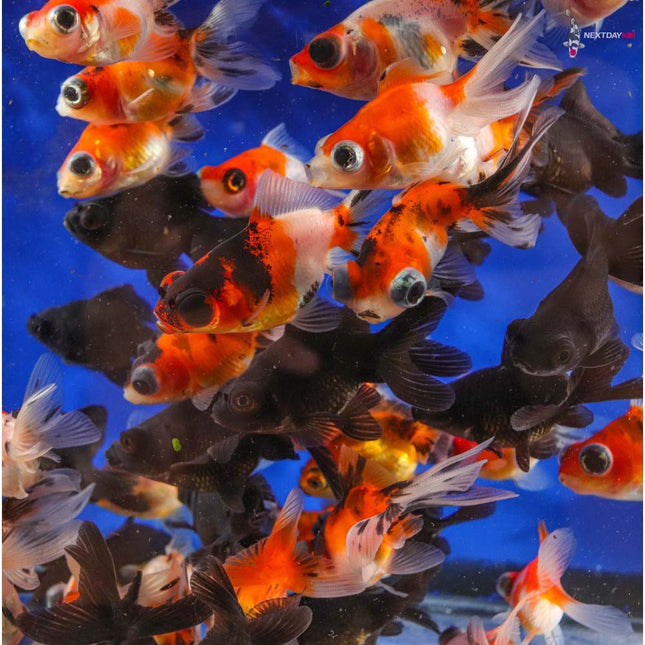
These Assorted Telescope Eyes Goldfish are perfect for coldwater aquariums. With their unique telescope-like eyes, these fish will add a fascinating touch to any tank. Please note that most will be Black Moors. These fish are located offsite.
$12.00

The Tuxedo Endler Guppy is a popular and colorful strain of the Endler's Livebearer (Poecilia wingei) species. These small, active fish are known for their bright colors and active personalities, making them a popular choice for aquarium hobbyists. Tuxedo Endler Guppies are known for their striking black-and-white tuxedo-like patterns, with black markings on their tails, dorsal and anal fins, and black patches on their bodies, contrasting with their white or silver bodies. They are a hardy fish that can thrive in a variety of water conditions, making them an ideal choice for beginners. In addition to their striking appearance, Tuxedo Endler Guppies are also known for their active and playful behavior. They are social fish and do well in groups, so it's recommended to keep them in groups of six or more. They are also relatively peaceful and can be kept with other small, non-aggressive fish species. Overall, Tuxedo Endler Guppies are a beautiful and entertaining addition to a community aquarium.
$15.00
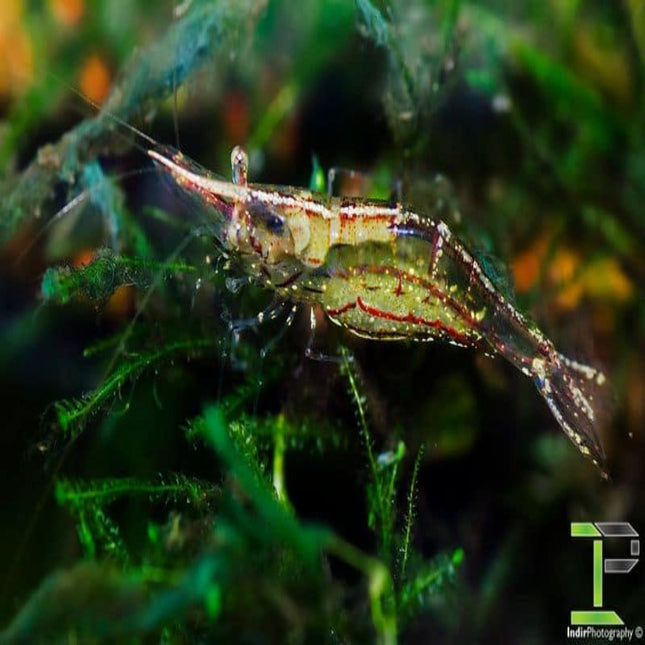
WE DON'T SEND TO TAS OR WA WITHOUT BIOSECURITY CONSENT. Caridina sp NTnilotica - also called ""Darwin Algae Shrimp" or "algae eater shrimp"- is a freshwater species of doube periophthalmate shrimps belonging to the Atyidae family. It was named after P. Roux's research in 1833 and it has its natural habitat over Africa - between the Nile River in Egypt to Lake Sibaya in South Africa and only can be found in Lake Victoria, the source of the Nile River; on other hand according to some sources, this shrimp's homeland is northern Australia, as a significant part of resources on this species belongs there too. There is no doubt the Darwin Algae Shrimp are often confused with Caridina Longistiris. But they differ from each other in many ways. One of their most distinctive features is that it has a white stripe extending from its head to its tail, depending on what time of day or whether it's eating something The males are smaller and less colourful, while the females are larger and more colourful. These shrimps can reach 4-5 cm in length. Water Parameters: pH: 6.5-8 Hardness: soft to hard Temperature: 18-28C Type: Freshwater Darwin algae shrimps prefer to live in aquariums that have high-quality clear water. Unlike snails, they can't tolerate pH levels much either and should be kept in soft or medium hardness environments. However, sudden changes to the temperature of the water will harm them too so it's best to use a heater and thermostat for stability. Darwin algae shrimps are peaceful and will do well with tank mates that are close to its size. It is not able to live in harmony with fish that show territorial protection or large sizes. This can be a problem, as Darwin algae shrimps have been observed being eaten due to their small size from time-to-time. Aggressive and larger fish can always pose a threat, so it may get along better living tanks mates who also have calm behaviour like itself The Caridina sp. Ntnilotica is a shrimp that's generally active in its behavior. This brave shrimp can compete with smaller fish over food and it also has the potential to be hardy if you set up the aquarium properly. If this shrimps movement slows down for just a brief moment, do not worry, as they are cautious around their tankmates so there is no need to panic when this happens! However, if this slowness continues for longer periods of time then it may be due to various diseases that have occured in your shrimp or its habitat… The Darwin Algae Shrimp do not harm aquatic plants, and they mostly live in harmony with them. They are typically preferred to be kept in planted aquariums. Feeding Darwin Algae Shrimp species is a good algae eater. However, their natural feeding areas are the rocky areas densely covered in moss and algae populations. To keep them healthy, it's best to provide an adequate amount of algae or establish one in your tank by exposing rocks or other decorations to high light and moving them into your shrimp tank. If you don't have any on hand - they can be fed dry food occasionally. In addition, if there are microorganisms present that are substantial enough - they will eat those too! But first choice will always be the algae available for consumption. Breeding Little information is available about the reproduction of Darwin Algae Shrimp. There are some observations in Australia for mating time. For instance, before mating, female molts and is surrounded by males during this molting period. After mating the female carries gray eggs that she incubates until they hatch into juvenile shrimp who resemble their parents and then move to a freshwater environment when they grow up in natural conditions (in captivity juveniles must be manually taken from half-strength saltwater over to freshwater). But it's important to provide proper food sources like plankton or otherwise juvenile shrimps will not survive as well Do we have the real deal? A lot of sellers online normally sell Glass Shrimps (Paratya australiensis) and it is very easy to make this mistake as well. In order to resolve the species that we have in stock we have unknowingly done the following: We accidentally sent invertebrates to a customer in Western Australia and it had been ceased by WA Quarantine as Inverts are not allowed in WA. Due to this the package was ceased and awaiting euthanisation. However while waiting for euthanisation the Quarantine Officer decided to put this up for testing. The initial test discovered that this was classified as Paratya australiensis. However later in the day it was pointed that it was a human error where the pheonotype that was used was Paratya australiensis in the WA Quarantine Database. This has been subsequently resolved and the correct name has been established for this species which is Caridina longisrostris. Due to this knowledge and by direct confirmation from Quarantine WA (July 2020). NTA is confident that we sell Caridina longisrostris and not Paratya australiensis. When you purchase from NTA be assured that you will be getting the real shrimps that has been sustainably harvested by a licensed collector from Far North Queensland. What is it good for? Caridina longisrostris is useless on algae that is stuck on the glass or on rocks that has a smooth texture. They will not touch these kinds of algae and it is better that you use Otocinclus for this. What Caridina longisrostris is good for is Black Beard Algae BBA or Green Algae. They will also eat dead or decaying leaves. If there are none of the above they will eat the biofilm in the tank. ONLY if there is nothing left they will eat live plants. However this is very unlikely to occur. Also, another component that we have observed is that these shrimps will eat left over fish food and also will cannibalise if one of the shrimps is weak or there is a failed molt. They will also attack dead fish. Is it right for you? If you enjoy efficient algae cleaning machine this shrimp is for you. When you buy 6 or more it is safe to put it in a Betta tank as well. Photo credit by Indir Tupkovic. Used with Permission. All rights reserved.
$5.00
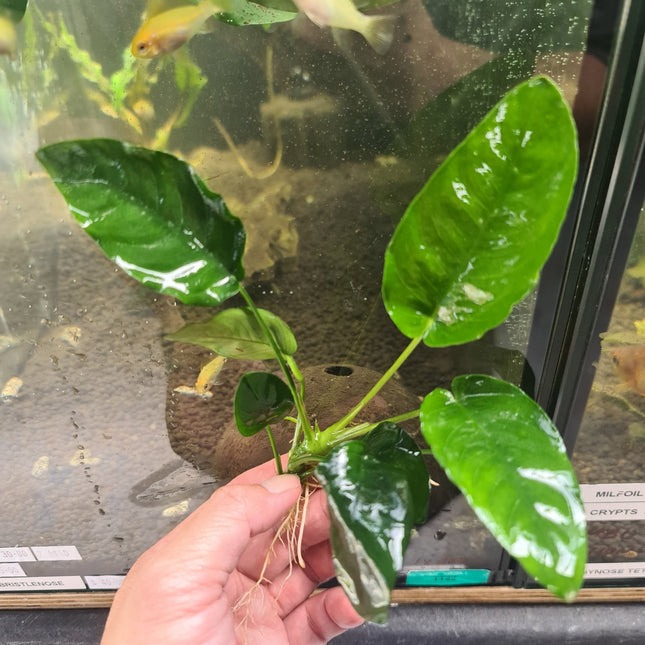
Sold as individual pieces in a terracotta pot The image is an example of the quality you are getting
$25.00

This Albino Blue Topaz Guppy features two distinct genders, male and female. This unique trait allows for the creation of vibrant and varied varieties of color in the fish. The Albino Blue Topaz Guppy is sure to enhance any aquarium.
$25.00 - $30.00
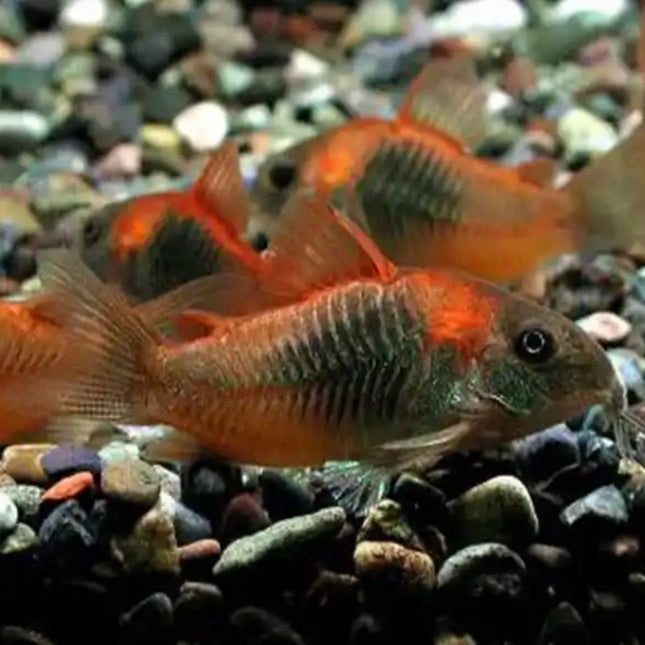
Corydoras Venezuela, also known as Venezuelan Corydoras or Corydoras adolfoi, is a small, peaceful catfish species that originates from the Orinoco River basin in Venezuela. These charming catfish are known for their striking appearance, with a unique pattern of black spots and bands on a light-colored body. They have a streamlined shape, with long barbels around their mouths that they use to search for food in the substrate. In addition to their eye-catching appearance, Corydoras Venezuela are known for their peaceful and social nature, making them great additions to community aquariums. They are generally peaceful with other fish species, and are best kept in groups of 5 or more to promote their natural shoaling behavior. Corydoras Venezuela are also hardy and easy to care for, making them suitable for beginner and experienced aquarists alike. These catfish are omnivorous, and their diet consists of a variety of foods including high-quality dry pellets, frozen or live foods such as bloodworms, brine shrimp, and daphnia, as well as vegetable-based foods like algae wafers or blanched vegetables. They are bottom-dwelling fish that will actively forage in the substrate for food, helping to keep your aquarium clean. At Nano Tanks Australia Aquarium Shop, we take pride in offering healthy and high-quality Corydoras Venezuela to our customers. Whether you're a seasoned hobbyist or just starting out, these captivating catfish are sure to add beauty, charm, and activity to your aquarium. Don't hesitate to contact us for expert advice or browse our selection online. Get your Corydoras Venezuela from Nano Tanks Australia Aquarium Shop today and elevate your aquarium to the next level! Happy fishkeeping!
$15.00

Synodontis Petricola: The most peaceful freshwater fish Overview: Synodontis petricola is a catfish which grows up to 4 inches long. The species can be found in Lake Tanganyika, and it’s rare amongst aquarists because of how hard they are to find! This freshwater fish are the most peaceful of its kind, and with their inquisitive nature, they benefit well from stimulating décor arrangements. Housing them in a LakeTanganyika biotope setup is advised; giving enough open water for swimming as well as using rocks to form caves for exploration. Dim lighting will encourage the fish do more social activities amidst themselves. Fish Keeping Guide Classification Mochokidae Name Origin Synodontis: Ancient name for an undetermined fish from the Nile Petricola: A dweller among rocks. Care Level Medium Fish Size This species grows to a length of 10.2 centimetres (4.0 in) Water Temperature 24-28°C pH 7.5-8.5 Water hardness 10-35 dH Aquarium Size Required 36″ x 12″ x 12″ (90x30x30cm) – 80 litres Gender Differences Females more round in shape and a darker colour Feed Sinking pellets, although will also benefit from frozen and live foods Compatibility Should only be kept with larger Tetras, Barbs, and Gourami in a community set up that like harder water quality. Ideal tank mates with most Cichlids, especially African Mouthbrooders Characteristics: The Synodontis petricola is light brown in color and covered by numerous, irregular dark brown spots. It has smaller ones on its head and ventral region, with white tips and a darker base on the pectoral fins, dorsal fins as well as the anal fin. Its humeral process is trilateral or three sided; it also has gill openings that do not cross over the pectoral fin spine. Behaviour: Synodontis Petricola are good-natured and sociable fish that do best when kept in groups of 3-4 or more; if kept singularly, they can be quite cautious, preferring to hide among rocks or caves.If you have appropriately sized rainbowfish, livebearers and water cichlid communities in your tank, Synodontis petricola makes a great tank mate. However it's not advised to house them with fish that are too small for their size as they might be mistaken for food. Breeding The Syndontis Petricola are known for their reproduction in aquaria. Whilst they reproduce quite often in open waters, this species is unusual due to the fact that it is one of a few fish who have a breeding method called 'Brood Parasitism'. The Syndontis Petricola time their spawning to coincide with African Mouthbreeders and lay eggs near theirs. As the catfish eggs hatch, young fry consume mouthbrooder's eggs and are protected by unsuspecting cichlids.The most effective way to breed Syndontis Petricola in captivity is to raise the eggs in a separate breeding tank. It is also recommended that adults are removed from the fish tank once they have spawned so as not to eat their own eggs. Spawning of pairs or flocks, ample frozen and live feed should be provided for them.
$20.00
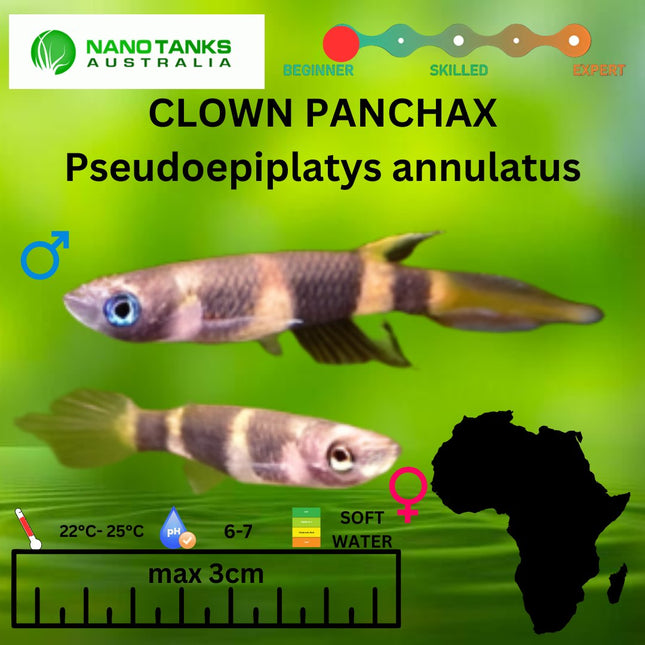
Described By: (Boulenger), 1915 😊 Description Temperament Peaceful Predator Colour Form Varied Bright Colours. Males - Coloured Tails ♂️ Females - Plain Tails ♀️ Lifespan Roughly 5 years Diet 🥩 Carnivores - feeds on pellets, live foods and frozen foods. Minimum Tank Size 20 Litres Tank Setup Plants - Such as Duckweed, Anubias or Java Fern with many rocks and woods. Such as Dragon Stone, Dragon Wood, Quan Woods. Compatibility Peaceful - However due to the size please be aware that it can be eaten by bigger fish. To keep your Clown Killifish happy, their habitat should be well lit, water parameters excellent, and a gentle current from the filter set. If you give your clown Killies these conditions, they can live for 5 years! Rocket Killie Clown Killies are also known as rocket killies and banded panchax. Coming from western Africa, they are found in southern Guinea, Liberia, and Sierra Leone. The Clown Killifish is a peaceful micro-predator that feeds primarily on tiny flying insects and invertebrates. 😊 Can we expect some clowning around? Clown Killifish are shy (they are rather small) but they will become more playful when in a group, so expect some interesting schooling behaviour. They even enjoy jumping out of the water for some fun! Make sure to keep their tank lid tightly fitted so that these fish can have as much space as possible to live and play around without the risk of an excursion on the floor. 😊 A unique look Clown Killifish are also called Rocket Killies because they resemble tiny rockets. In addition, they have torpedo-shaped bodies that help them swim up for food, and they even appear as a fishy clown with round heads and spade-like tails. 😊 Keeping Clown Killifish in the Aquarium You can choose to house Clown Killies in larger community tanks that are already occupied by other species. The downside is the fish won't reproduce as often if they're placed with another type of inhabitant, so you should know what kind of goal you have for keeping these types of fishes before giving them a home. 😊 Are these fish easy to breed? If you have a male and female in your tank, don't worry about mating. Just maintain healthy water parameters to keep them alive, and they will breed when it's the right time every month! Clown Killies are prolific parents who can produce up to 25 fry per cycle - twice each month until their population numbers get out of hand! 😊 Feeding your Clown Killies Clown Killies are carnivores that need a lot of meaty protein, but they can only eat tiny portions. They lay in wait for the insects to land on the water's surface and then eat their prey - or what could be considered for them a tasty meat morsel! Ideally, in captivity, we can try mimicking what can be in the natural environment: baby brine shrimp 1-2 times a day should do it! There is advice on other foods on the internet but realistically, sticking with brine shrimp for a treat is good enough and achievable without spending a fortune. PLEASE CONTACT US FIRST BEFORE YOU ORDER ANY FEMALES AS WE WILL HAVE TO CHECK OUR STOCK!
$15.00
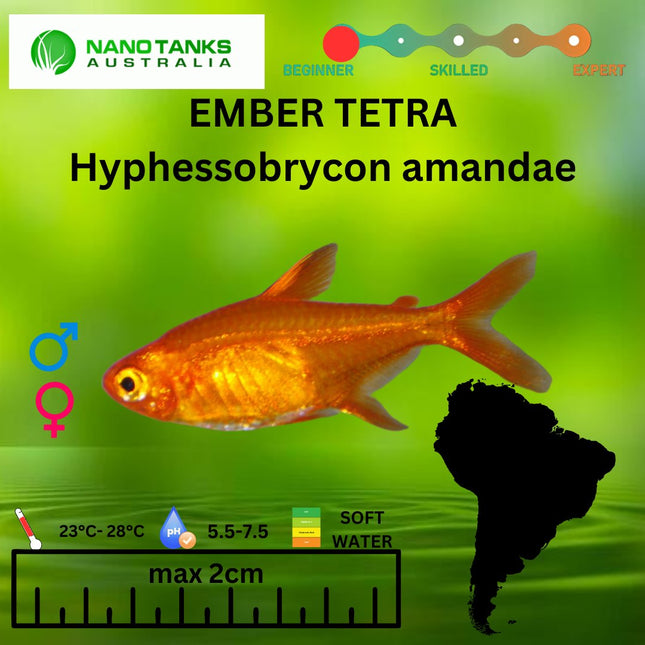
Described By: Géry & Uj, 1987 😊 Description Temperament Peaceful Predator Colour Form Varied Bright Colours. Not Sexually Dimorphic - difference only when eggs are present. Lifespan Roughly 2 years Diet 🥩🌿 Omnivores - feeds on pellets, live foods and frozen foods. Minimum Tank Size 20 Litres Tank Setup Plants - Such as Duckweed, Anubias or Java Fern with many rocks and woods. Such as Dragon Stone, Dragon Wood, Quan Woods. Compatibility Peaceful - However due to the size please be aware that it can be eaten by bigger fish. 😊 Habitat Little information appears to exist but presumably inhabits minor tributaries, backwaters and oxbow lakes rather than main river channels. In the Araguaia drainage such habitats typically contain soft, weakly acidic water with the substrate covered by a layer of fallen leaves and branches. 😊 How many ember tetras in a 10 gallon tank? In a 10 gallon tank you can have around 12 - 18 ember tetras. 😊 How many ember tetras in a 5 gallon tank? In a 10 gallon tank you can have around 6 ember tetras. 😊 How to breed ember tetras? Ember Tetras are egg scatterers. Most people don't really bother with breeding Ember Tetras as they are a low value fish. In Australia, if you were going to breed anything, consider breeding fighting fish or shrimps. 😊 What do ember tetras eat? We recommend you provide Ember Tetras with plenty of varied foods like Hikari Micro Pellets or Prestige Bettas Golden Pearl Fry Foods.
$5.00

Interesting Facts About The Ramshorn Snails Overview Ramshorn Snail is a prevalent aquarium species that plays a significant role in keeping your tank clean. They feed on decayed plants, fish waste, debris, algae buildup, and uneaten fish food. These aquatic snails sneak their way through tanks, hitch themselves and lay eggs to live plants. Depending on the objective, these aquarium tank mates can serve as a helpful cleaner or be a pest. Compared to other types of snail, Ramshorns require minimal snail care that making them one of the top species in the aquarium trade. As a result, these snails are available to most pet stores nowadays. Characteristics Ramshorn snails differ significantly in their appearance. Both its skin and shell can be different in colors, creating numerous color combinations. There are varieties such as common, pink, blue, and red ramshorn snails. Their typical skin color is either red or black. Red snails have a vibrant color because of their red blood hemoglobins. On the other hand, Black snails have melanin pigment that the red ones don't possess. Unlike other freshwater snails, Ramshorns don't have an operculum. As a result, these snails are not able to breathe underwater and must breathe air instead. Ramshorn snails are hermaphrodites that can grow up to 1 inch as they get older. Their average life span is in between 1 to 3 years. Tank requirements Ramshorns are solitary and peaceful snails that can quickly adapt to various water conditions. These freshwater aquarium snails love planted tanks and enjoy stable water quality. However, they are mainly being targeted by aggressive fish, so keeping them with the peaceful ones is necessary. The ideal tank size should be at least a 5-gallon tank, but it is advisable to upgrade into a 10-gallon tank if you're planning to keep multiple snails. Water Parameters Ph Level: 7 - 8 Hardness (GH) : 7 - 15 Carbonate Hardness (KH): 8 Nitrate: Below 20 ppm Temperature: 70°F – 78°F Tankmates More extensive, aggressive fish are mainly targeting ramshorn snails. It ideal keep them with peaceful tankmates like shrimp, clams, friendly snails, gourami, danios, and teras. Note: Some aggressive snails like the Assassin snail love to devour pond snails, ramshorn snails, and Malaysian trumpet snails. Feeding Before anything else, it is vital to be sure that the food you will serve to your snails is copper-free as they could quickly die from it. By any chance, If you cannot avoid putting copper-contained products into your tank, it is highly recommended to transfer the snails to a different aquarium. Ramshorn snails are can easily be fed, and one of their favorites is algae. They are bound to search for algae all over the tank. They also feast on rotting plants, dead shrimp and fish, uneaten food like pellets and fish flakes. You can always give them some treats like algae wafers and vegetables like cauliflower, lettuce, cucumber, and squash. Breeding all you need to have is at least two of them because ramshorn snails are hermaphrodites, meaning they have sexual organs of both male and female. And because of that, they could quickly breed with any other snail. These snails lay multiple egg clusters all over the tank. Each group contains an average of 12 eggs. And after few days, the baby snails will be visible from the inside.
$6.95

* * * FROZEN FOOD * * * * For saltwater and freshwater fish or for turtles as an occasional treat. Includes 35 portions that can broken off. Ingredients: Blood worms, multi-vitamins, water for processing. Made in Indonesia. Shipping is only available for quantities 20 or more. Please note that you should be using FROZEN FOODS as the appropriate shipment method
$6.00
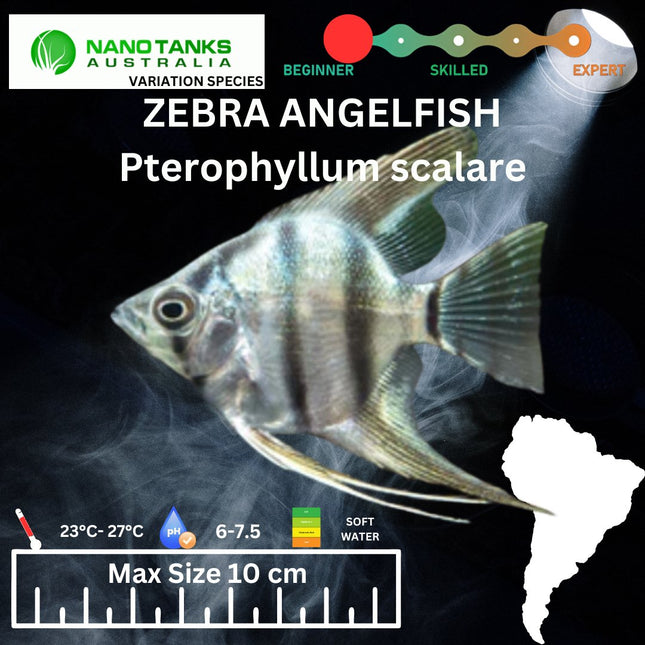
Welcome the beauty of the Zebra (Panda) Angel Fishinto your home! This exquisite fish boasts vibrant black scales and a graceful, flowing tail that will be sure to spark admiration.
$25.00
![[ARRIVED 18 - JUL - 2025] Gold Gourami Trichopodus trichopterus 3 - 5cm - Nano Tanks Australia](http://nanotanksaustralia.com.au/cdn/shop/files/arrived-18-jul-2025-gold-gourami-trichopodus-trichopterus-3-5cm-3433725.jpg?v=1752832410&width=645)
Overview Synonyms Labrus trichopterus, Trichopus trichopterus, Trichopus sepat, Trichogaster trichopterus, Osphromenus siamensis, Osphromenus insulatus Distribution A captive bred colour form Maximum Size 15cm (6") Temperature 23-30°C Water Parameters Will acclimatise to a wide range of conditions. pH: 6-8, dH: 5-20 degrees. Compatibility Community with no long-finned fish Lighting No special requirements Sexual Dimorphism Males have a longer and more pointed dorsal fin. Feeding Flake, granules and frozen foods Description Care Gold Gouramis are a domesticated strain of Blue gourami and are a familiar sight in community set ups. Males are inclined to be rather competitive with one another and show the marbled pattern seen in other forms when at their most assertive. These fish have long been used as a larger accent fish amongst smaller shoaling species and the key to successful cohabitation is to keep them occupied. Although gouramis are often sold as pairs, these are not monogamous fish and males will court females in the knowledge that they'd leave his territory if they weren't interested. In the confines of an aquarium this is not an option, so add multiple females to spread the male's attention. The sexes can be easily distinguished by the shape of their dorsal fin - small and rounded in females, long and pointed in males. As this fish comes in many colour forms such as Blue, Opaline, Three-spot, Gold and White (a very pale strain of gold) these can all be mixed if you so desire. To allow them to avoid one another on occasion, the aquarium should be over 90cm/36" in length, with a good amount of aquatic planting to provide shelter and break the sightlines. Like most gouramis, the hair-like pelvic fins are equipped with taste buds and are used extensively to investigate their environment and one another. Feeding An omnivorous species which should be offered a varied diet consisting of a good quality flake food, green flake food, and frozen foods such as mosquito larvae, brineshrimp etc. This species should also be allowed to graze on soft fine-leaved plants. Breeding This egg-laying species can be bred successfully in the aquarium. Males build a bubble nest at the waters surface and initiate spawning. As soon as the eggs have been fertilised, the male usually gathers them up and places them in the nest. The female should be removed immediately after spawning has ceased as the male will continually try and drive her away, causing her much stress in the closed environment of an aquarium. The male will tend to the eggs until they hatch and the fry are free-swimming.
$15.00
![[ARRIVED 18 - JUL - 2025] Red Wagtail Platy 2 - 4cm - Nano Tanks Australia](http://nanotanksaustralia.com.au/cdn/shop/files/arrived-18-jul-2025-red-wagtail-platy-2-4cm-3129312.jpg?v=1752832410&width=645)
The red wagtail platy is a pleasant and peaceful freshwater fish that's both hardy and active. It's also small, pretty, and a great fish for hobbyists of any level; in fact, it's one of the most popular in the fishkeeping industry. You can find platies in several different colors which make for an eye-catching tank. The platy has two goals in life: eating and breeding. They will circle the tank eating anything, including algae, and their breeding can't be stopped. Like guppies, platies are livebearing fish. Species Overview Common Name: Red wagtail platy Scientific Name: Xiphophorus maculatus Adult Size: 2-3 inches Life Expectancy: 4 years Characteristics Family Poeciliidae Origin Guatemala, Honduras, Mexico Social Peaceful Tank Level Mid-dweller Optimal Tank Size 10 gallon Diet Omnivore, eats most foods Breeding Livebearer Care Easy pH 7.0 to 8.0 Hardness 10 to 28 dGH Temperature 64 to 78 F (18 to 26 C)
$9.00
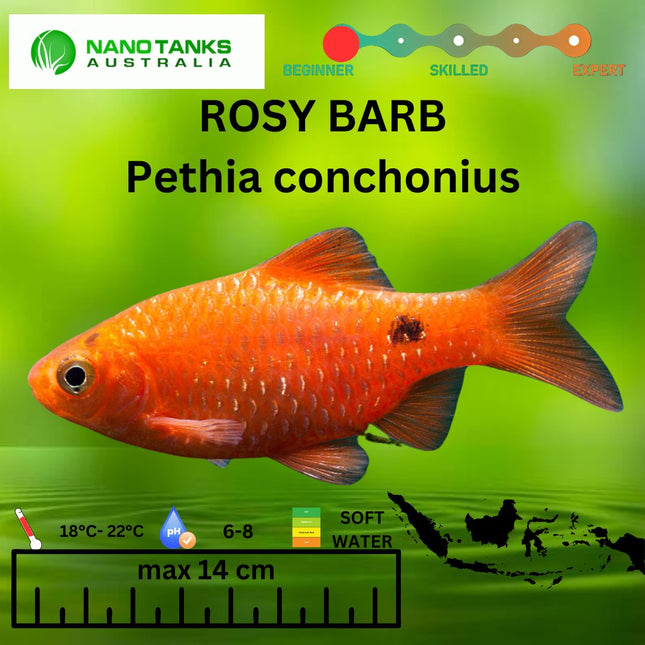
Brilliant Pink Energy for Your Aquarium! Short Description:Light up your tank with the vibrant energy of Rosy Barbs! These active, schooling fish feature stunning pinkish-red coloration that intensifies with proper care, creating a dazzling display of movement and color. Perfect for community aquariums, these hardy fish bring both beauty and personality to your aquatic world. Key Features & Highlights 🌸 VIBRANT COLORATION: Males develop intense rosy-pink bodies with fiery red fins and golden highlights - color intensifies during breeding and with optimal care 🐟 ACTIVE SCHOOLING BEHAVIOR: Constantly in motion, these energetic fish create a captivating display when kept in groups of 6+ 💪 HARDY & ADAPTABLE: Tolerate a wide range of water conditions, making them perfect for beginners and experienced aquarists alike ☮️ PEACEFUL COMMUNITY FISH: Excellent companions for other active, similarly-sized fish in well-planned community tanks 🎯 PERFECT SIZE: 3-5cm juveniles ready to grow and color up in your aquarium - ideal for most home aquariums Detailed Description Meet the Rosy Barb - a classic aquarium favorite that continues to win hearts with its perfect combination of stunning beauty, engaging behavior, and easy care. These energetic fish transform ordinary aquariums into dynamic underwater spectacles with their constant movement and brilliant coloration. What makes Rosy Barbs special is their remarkable color transformation. While juveniles show subtle hints of pink, mature males develop into living jewels with intense rosy bodies, dark-edged fins, and golden highlights that shimmer under aquarium lighting. Kept in proper schools, they display fascinating social behaviors and create a mesmerizing display of coordinated movement. These active swimmers are particularly well-suited to planted aquariums with open swimming spaces. Their hardy nature and adaptability make them an excellent choice for aquarists seeking colorful, low-maintenance fish that thrive in various conditions while providing endless entertainment. Perfect For: Active community aquariums Beginner hobbyists Planted tanks with open spaces Schooling fish displays Colorful focal points Specifications & Care Guide Parameter Requirement Scientific Name Pethia conchonius Common Names Rosy Barb, Red Barb Tank Size 20+ gallons for school Temperature 64°F - 72°F (18°C - 22°C) pH Range 6.0-8.0 Water Hardness Soft to hard (5-19 dGH) Adult Size 4-6 cm (1.5-2.5 inches) Diet Omnivorous - flakes, pellets, live/frozen foods Lifespan 3-5 years Care & Feeding Tank Setup: Prefer planted tanks with open swimming areas Appreciate moderate water flow School of 6+ individuals recommended Peaceful tank mates only Diet: High-quality flake or pellet food Occasional live/frozen treats (bloodworms, brine shrimp) Vegetable supplements Feed 2-3 times daily in small portions Water Quality: Regular water changes recommended Adaptable to various water conditions Avoid extreme parameter fluctuations Important Considerations ⚠️ SCHOOLING REQUIREMENT: Must be kept in groups of 6+ for natural behavior 🚫 FIN-NIPPING TENDENCY: May nip long-finned fish (avoid with bettas, guppies) 🌡 COOLER WATER PREFERRED: Thrive in slightly cooler temperatures than tropical fish 🐠 ACTIVE TANKMATES: Best with other active, robust fish species 🌿 PLANT SAFE: Generally leave plants alone but may nibble tender shoots 🔄 REGULAR FEEDING: Active metabolism requires regular meals Live Arrival Guarantee Our Rosy Barbs are carefully acclimated and conditioned for shipping. Each order includes detailed care instructions and our live arrival guarantee ensures your fish arrive healthy and ready for their new home. Ready to add vibrant energy to your aquarium? Bring home these colorful schoolers today!
$3.00
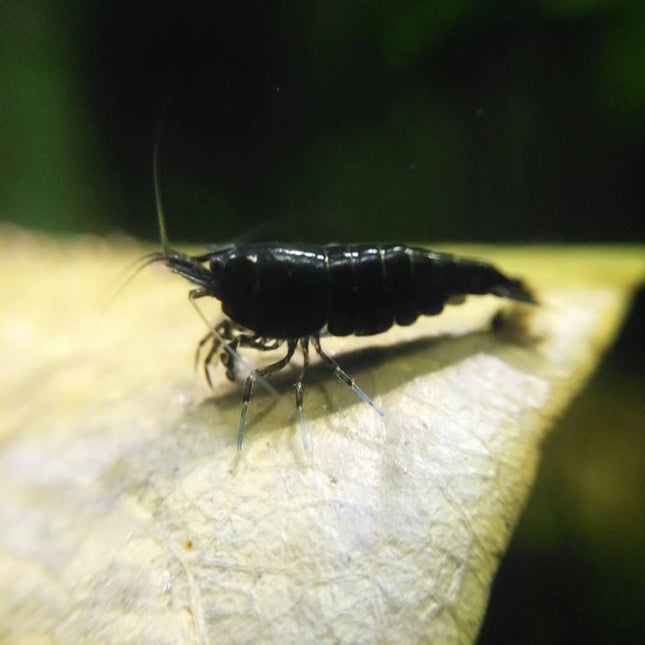
The black variation of the Red Cherry Shrimps All are subadults. Image from https://www.pinterest.com.au/pin/41939840258651870/ NO SHIPPING TO WA
$25.00
![[ARRIVED 18 - SEP - 2025] Sponge Filter XY2835 | Sponge Filter for Aquarium - Nano Tanks Australia](http://nanotanksaustralia.com.au/cdn/shop/files/arrived-18-sep-2025-sponge-filter-xy2835-sponge-filter-for-aquarium-6792984.jpg?v=1758206795&width=645)
Superior Biological Filtration, Gentle Water Flow, and Reliable Performance. The Sponge Filter XY2835 is the workhorse of the aquarium world, offering incredibly efficient biological and mechanical filtration with a gentle, fish-safe current. Its dual-sponge design provides a massive surface area for beneficial bacteria to colonize, making it the ideal choice for breeding tanks, hospital tanks, shrimp tanks, and as a supplemental filter in community aquariums. Simple, effective, and affordable. Key Features & Benefits: Massive Bio-Load Capacity: Two large, porous sponges offer an enormous surface area for beneficial bacteria, providing stable and superior biological filtration to break down harmful ammonia and nitrite. Gentle & Safe Flow: The gentle bubbling action is perfect for delicate fish (like bettas), fry, shrimp, and other creatures that could be stressed or harmed by strong filter intakes. Dual-Purpose Filtration: The sponges provide both mechanical (traps debris) and biological (hosts bacteria) filtration, keeping your water crystal clear and healthy. Cost-Effective & Efficient: Operates with a standard air pump, making it one of the most energy-efficient and affordable filtration options available. Versatile & Reliable: Ideal for a wide range of setups, from 40 to 150-litre tanks (10-40 gallons), and is famously reliable with no moving parts to break. Product Details: Product Name: Sponge Filter XY2835 Model: XY2835 (55mm x 48mm) Recommended Tank Size: 40 - 150 Litres (10 - 40 US Gallons) Required Equipment: Must be powered by a standard aquarium air pump (sold separately). Includes airline tubing and a suction cup for mounting. What's Included: 1 x Filter Body, 1 x Sponge Sleeves, 1 x Weighted Base, 1 x Lift Tube. How To Use: Connect: Attach one end of the included airline tubing to the uplift tube of the filter and the other end to your air pump. Place: Submerge the filter completely in your aquarium. Use the weighted base or suction cups to secure it in a corner. Power: Plug in your air pump. You will see a stream of bubbles rising up the lift tube, which creates the water flow that pulls water through the sponges. Maintain: Rinse the sponges in a bucket of old tank water during water changes to remove debris. Never rinse them under tap water, as chlorine will kill the beneficial bacteria. Who is this filter for? The Sponge Filter XY2835 is the ideal choice for: Breeders: For fry and shrimp tanks, preventing tiny offspring from being sucked into the filter. Shrimp Keepers: Provides safe filtration and a constant food source for shrimp as they graze on the sponge. Betta Owners: Offers gentle flow that won't stress long-finned fish. Hospital/Quarantine Tanks: Provides instant biological filtration without strong currents. Community Tanks: Excellent as a supplemental filter to boost biological filtration. Order with Confidence: A cornerstone of effective aquarium keeping, this filter is a must-have for hobbyists of all levels. FAQ Section (Suggested for the product page): Q: What size air pump do I need for this filter?A: For tanks up to 75L (20 gallons), a standard single-outlet pump is sufficient. For larger tanks (up to 150L/40g), a stronger dual-outlet pump is recommended to ensure adequate flow. The deeper the tank, the stronger the pump needed to push air down. Q: How do I clean it without killing the good bacteria?A: Always clean the sponge in a bucket of water you have removed from the aquarium during a water change. Gently squeeze the sponge to release trapped waste. Using tap water will chlorine will destroy the beneficial bacteria colony. Q: Is the current really safe for baby fish and shrimp?A: Absolutely. The water is drawn gently through the porous sponge, making it 100% safe for even the smallest fry and shrimp. There are no intakes or impellers to cause harm. Q: Can I use this as my only filter?A: Yes, for many setups. It excels in biological filtration. For heavily stocked tanks, it can be used as the primary filter. For tanks that produce a lot of waste, it's best paired with a filter that provides stronger mechanical filtration (like a hang-on-back) to polish the water. PLEASE NOTE THAT THE BOX MAY VARY DEPENDING ON THE SOURCE
$5.95
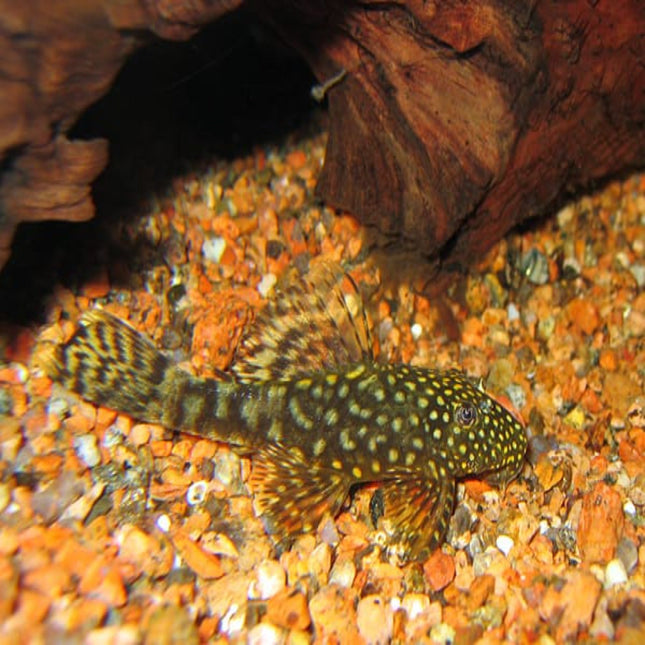
Ancistrus, also known as bushynose or bristlenose catfish, is a genus of nocturnal freshwater fish in the family Loricariidae of order Siluriformes, native to freshwater habitats in South America and Panama. The common Bristlenose is commonly captive bred appears impossible to identify to species primarily due to a lack of original locality information but also because tens of undescribed congeners exist. Ancistrus species show all the typical features of the Loricariidae. This includes a body covered in bony plates and a ventral suckermouth. The feature most commonly associated with the genus are the fleshy tentacles found on the head in adult males; females may possess tentacles along the snout margin but they are smaller and they lack tentacles on the head. Tentacules, tentacles directly associated with odontodes, develop on the pectoral fin spine of the males of some species. Sources: Wikipedia contributors. (2019, October 19). Ancistrus. In Wikipedia, The Free Encyclopedia. Retrieved 02:58, October 19, 2019, from https://en.wikipedia.org/w/index.php?title=Ancistrus&oldid=921971242/nAncistrus. In Planet Catfish. Retrieved October 19, 2019, from https://www.planetcatfish.com/ancistrus_cf_cirrhosus
$15.00
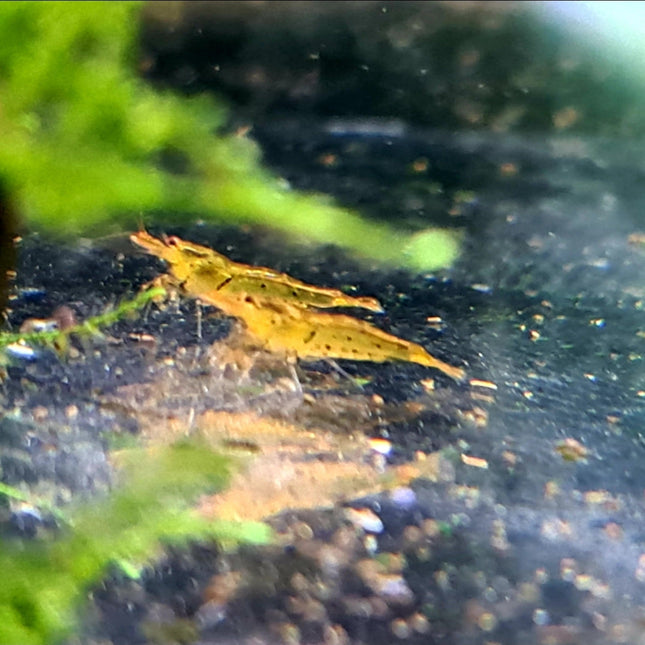
General care for shrimp: Temperature:18°-24°C Chlorine/chloramines: 0 ppm (very toxic for shrimp) Ammonia/Nitrite: 0 ppm. Nitrate: <20 ppm. pH: 6.2-7.5. GH: 4-8 dGH KH: 3-15 dKH Name Optimal TDS Limits Cherry shrimp 150 – 200 100 – 400 Cardinal shrimp 100 50 – 150 Tiger shrimp 180 – 220 100 – 300 We strongly recommend to drip acclimate any shrimp untill the TDS matches before you release the shrimp into your tank. Please note the above is just a general indication of the care requirements of shrimp. Results will vary depending on the individuals set up.
$15.00

Add a splash of colour to your aquarium with the Assorted Hi Fin Platy. These colourful tropical fish are a great addition to any freshwater tank, and their vibrant fins add beautiful detail and intrigue. Their peaceful nature makes them an ideal choice for any community tank.
$12.00

The Glass Shrimps are endemic to Australia and they inhabit many of our inland habitats. They mostly inhabit streams and tributaries on all States in Australia except for Tasmania. They can live in cool conditions (cold winter nights at Sydney) through to to the heat of Sydney's weather. They are an easy species to have and will graze on Algae or uneaten foods. They are not the best when it comes to algae control. Consider giving these gems a try. They reproduce with a planktonic stage and they are quick (as they live with Gambusia and other invasive species). A few people have tried them with Bettas. Although it is not recommended however in a planted Betta tank it is best to have them in a group of 5 or more. PLEASE NOTE THAT THIS SHRIMPS IS CURRENTLY HELD OFFSITE AND CAN ONLY BE PURCHASED THROUGH THE WEBSITE ONLY. IT IS CURRENTLY NOT AVAILABLE IN STORE.
$5.00 $4.00

When buying endlers we recommend either going all males or a ratio of 1 male to 2 females or more. this is to ensure the females are not getting too stressed out by the males who will constantly chase them wanting to breed. Temperature: 24 – 28°C pH: 6.5 – 7.8 Hardness: 8-12 dGH Lifespan: 2+ years Max Size: 3-5cm Diet: Omnivore
$18.00 - $30.00
![5BT11 - [ARRIVED 24 - MAY - 2025] Platinum White Cellophane Halfmoon Male Betta - Nano Tanks Australia](http://nanotanksaustralia.com.au/cdn/shop/files/5bt11-arrived-24-may-2025-platinum-white-cellophane-halfmoon-male-betta-574358.jpg?v=1748142084&width=645)
Discover this rare betta fish for sale in Australia, exactly as shown in the photos. Each fish is healthy, vibrant, and full of personality—making it the perfect addition to your aquarium. Shipped safely from Sydney, our bettas are ready to thrive in your home tank. Specifications: Males: Approx. 4–5 cm | Giant bettas: 7–9 cm Females: Approx. 3–4 cm | Giant bettas: 7–9 cm Age: 3–6 months Origin: Imported from Indonesia or Thailand Important Notes: Koi, grizzle, and fancy bettas may naturally change colour and pattern as they grow or during transit. Long-fin varieties may occasionally nip their own tails—this is a natural behaviour. All fish are kept in Sydney tap water (23–26°C, pH ~7) to ensure they’re well-adjusted and healthy. Shipping: We ship live bettas from Sydney every Monday and Tuesday for the safest transit. Please see our Shipping Policy for more details. Optional Video:Want a closer look at your betta before purchase? Order a video of your exact fish through the link provided.
$38.00
![5BT21 - [ARRIVED 2 - JUL - 2025] Galaxy Nemo Halfmoon Plakat Male Betta - Nano Tanks Australia](http://nanotanksaustralia.com.au/cdn/shop/files/5bt21-arrived-2-jul-2025-galaxy-nemo-halfmoon-plakat-male-betta-5360883.jpg?v=1751530418&width=645)
Discover this rare betta fish for sale in Australia, exactly as shown in the photos. Each fish is healthy, vibrant, and full of personality—making it the perfect addition to your aquarium. Shipped safely from Sydney, our bettas are ready to thrive in your home tank. Specifications: Males: Approx. 4–5 cm | Giant bettas: 7–9 cm Females: Approx. 3–4 cm | Giant bettas: 7–9 cm Age: 3–6 months Origin: Imported from Indonesia or Thailand Important Notes: Koi, grizzle, and fancy bettas may naturally change colour and pattern as they grow or during transit. Long-fin varieties may occasionally nip their own tails—this is a natural behaviour. All fish are kept in Sydney tap water (23–26°C, pH ~7) to ensure they’re well-adjusted and healthy. Shipping: We ship live bettas from Sydney every Monday and Tuesday for the safest transit. Please see our Shipping Policy for more details. Optional Video:Want a closer look at your betta before purchase? Order a video of your exact fish through the link provided.
$49.00
![5BT31 - [ARRIVED 2 - JUL - 2025] Red Blue Butterfly Halfmoon Betta Male - Nano Tanks Australia](http://nanotanksaustralia.com.au/cdn/shop/files/5bt31-arrived-2-jul-2025-red-blue-butterfly-halfmoon-betta-male-5912778.jpg?v=1751530418&width=645)
Discover this rare betta fish for sale in Australia, exactly as shown in the photos. Each fish is healthy, vibrant, and full of personality—making it the perfect addition to your aquarium. Shipped safely from Sydney, our bettas are ready to thrive in your home tank. Specifications: Males: Approx. 4–5 cm | Giant bettas: 7–9 cm Females: Approx. 3–4 cm | Giant bettas: 7–9 cm Age: 3–6 months Origin: Imported from Indonesia or Thailand Important Notes: Koi, grizzle, and fancy bettas may naturally change colour and pattern as they grow or during transit. Long-fin varieties may occasionally nip their own tails—this is a natural behaviour. All fish are kept in Sydney tap water (23–26°C, pH ~7) to ensure they’re well-adjusted and healthy. Shipping: We ship live bettas from Sydney every Monday and Tuesday for the safest transit. Please see our Shipping Policy for more details. Optional Video:Want a closer look at your betta before purchase? Order a video of your exact fish through the link provided.
$38.00
You have seen 612 out of 933 products